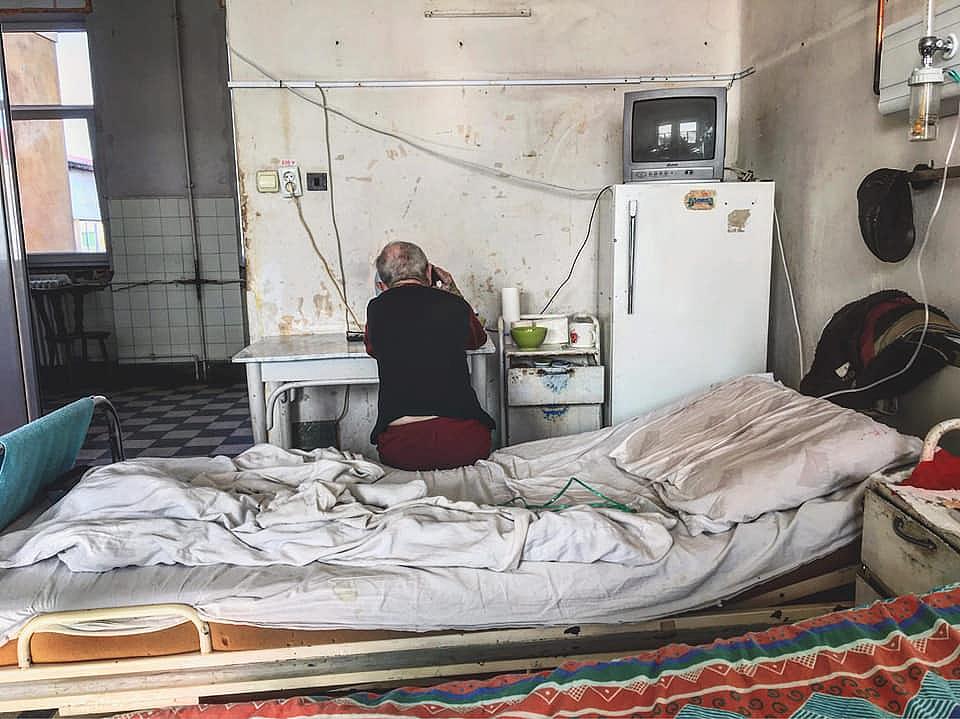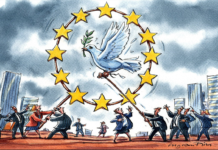As the novel coronavirus envelops the world in a dark narrative, some regions are more affected than others. While China seems to have stopped the epidemic, Western Europe and the U.S. have become the global hotspots for new cases of COVID-19 and subsequent fatalities. More vulnerable regions, such as Sub-Saharan Africa or the Indian subcontinent, are reporting relative small number of cases. While both regions, among others, are of great concern, Eastern and Central Europe is finding itself in the middle of a perfect storm.
The three horsemen of demographic apocalypse
I’ve done a piece a while ago regarding demographic decline in Romania and its three main factors: economic migration, falling birth rates and poor healthcare infrastructure. The conclusion was that the outlook is grim for Romania and for the wider region. The level of economic migration, particularly brain drain, that the country is seeing is unprecedented. According to a 2017 UN report, Romania was second only to war-torn Syria with regards to emigration growth rate between 2007 and 2015. Bulgaria, Hungary and Poland are not that far behind.
A 2020 International Organization for Migration report says about the region that “attracted by higher wages, a significant number of medical professionals from countries such as Romania, Poland and Slovakia have left their countries to work in Western Europe. It is estimated that, by 2015, Romania had lost half its doctors.” Not only that this part of Europe sees very little immigration to compensate for the massive emigration to Western Europe, it is also losing key people needed in a pandemic like the one that we are experiencing now. This is true for other neighboring countries as well.
A 2018 Quartz article summarized the disturbing projections of an UN report: Eastern Europe has the fastest shrinking population in the world. By 2050, Bulgaria’s population is expected to drop by 23%, from 7.08 million (2017), to 5.42 million people, while almost all countries in the region will experience drops of over 15% in this timeframe. Falling fertility rates across the region is a key factor in these statistics. Based on data extracted in March 2019 by Eurostat, roughly half of the countries in Eastern and Central Europe are above the 1.59 EU fertility rate median (live births per woman) but this is far behind the 2.1 value needed to replenish the population, in the absence of immigration. The evolution of this indicator is generally positive, with all the CEE countries experiencing growth compared to the 2000’s, but in the long-term, if there is no surge in fertility rates, the decline will continue, only at a lower rate.
The last horseman of the demographic apocalypse in the region is represented by high mortality rates. According to data pooled by Eurostat for 2016, the top ten countries in the EU ranked from highest to lowest deaths per 100.000 inhabitants are from Central and Eastern Europe, with Latvia having a frightening figure of roughly 1900 deaths, while the median value for the EU is around 1005 deaths per 100.000 inhabitants. Circulatory and heart disease is the biggest killer by far, with cancer coming second. Furthermore, what is even more concerning is the fact that if we total the deaths rates by heart and circulatory disease, cancer, lung cancer and respiratory disease, we basically get the same picture. With minor adjustments in the ranking, the top ten countries come from Central and Eastern Europe, which is a big deal taking into account that COVID-19 deaths are directly linked with these types of illnesses.
Another statistic regarding death rates which I think it is the saddest of them all is the share of avoidable deaths (treatable and/or preventable, for people bellow the age of 75) from the total number of deaths. Unfortunately, according to Eurostat, my home country of Romania tops the list with an alarming 80%. Again, we see the same pattern, with regional countries having very large percentages of avoidable deaths. Romania has a 31.9% share of treatable deaths, which means that roughly one third of deaths could have been “avoided through timely and effective health care interventions”, as the report puts it.

Facebook/Anamaria Czap via Știrile ProTV
This is a direct consequence of corruption plagued healthcare systems that have suffered from a rough transition from communism, the wild 90’s to the eventual integration in the European Union. For example, former Romanian Health Minister, Sorina Pintea, was recently arrestedfor allegedly taking a bribe to award a procurement contract to a supplier for a hospital where she was General Manager, at the time when the first coronavirus cases where reported in the country. This is but one of a myriad of cases brought to public attention in Romania regarding corruption within the medical industry. Corruption in healthcare systems around the world is called the ignored pandemic by Transparency International. The sobering report says that “corruption in the sector causes losses of over US$500 billion every year, more than it would cost to bring about worldwide universal health coverage.”
The state of the health infrastructure is a big problem in Eastern Europe, I can attest to that. In 2012 I was hospitalised for a nasty pneumonia in Marius Nasta pulmonary hospital, in Bucharest. It is hard to describe the state of the building that was housing hundreds of patients and medical professionals. Seen from the outside, the annex in which I was hospitalised was reminiscent of a deserted building in a war-torn region. On the inside, moldy walls with shriveled, old paint, overcrowded hospital rooms, the occasional cockroach, that was what I experienced for about two weeks. Certainly, my experience is not something out of the ordinary, but rather the norm. I’ve also experienced the effects of the ignored pandemic, which I will not explore here but at 31 now, I learned that it is a widespread practice in Romania, that only in recent years has been tackled by the authorities.
I was talking to a friend who is a doctor, working on the frontlines of Bucharest’s battle with the coronavirus, and he told me that several of his colleagues have resigned under enormous work pressure and stress, as well as due to the lack of medical supplies. When we think about what the emigration report cited above said about the medical brain drain that Romania and other regional countries are experiencing, we might understand the potential devastating impact of a northern-Italy style situation, here in Romania and in the wider region.
The novel horseman
Unfortunately, it is not a big revelation that the novel coronavirus epidemic in these countries will both exacerbate the phenomena I’ve described above and will be exacerbated by them. An acute medical crisis, like the COVID-19 pandemic, will wreak more havoc in countries affected by corruption in their healthcare systems and with high mortality rates, analogous to how the virus itself causes more damage to people with preexisting conditions. Eastern and Central Europe is a high risk patient, due to its demographic problems and their underlying causes.
Of course, demography isn’t the only thing that should be considered when analyzing the potential impact of the COVID-19 epidemic in the region. The political make-up of these countries, as well as the health of their economies, will both have a pivotal role in how will all of this plays out. Populism and iliberalism will most probably damage the effort to combat the disease, while the relative good GDP growth rates will be wiped out.
A Bloomberg analysis on how COVID-19 will impact GDPs around the globe in 2020 puts Eastern Europe, particularly Romania, Bulgaria, Hungary, at the forefront of most impacted regions, with a 6% decrease or more. Obviously, the impact will be global and will hit hard every country on Earth, not only Eastern Europe. It is exactly how Annie Lowrey described it in her article about quantifying the economic feedback from the epidemic: “this is not a recession, it is an Ice Age.”
Beyond the economic downturn and the awful impact on our healthcare systems, there will also be an impact in the mortality rate. How large will that impact be? In an opinion piece for Adevarul, I used an online platform called Causal, which made publicly available its tools, with already crunched-in data about the pandemic, with the goal to try to estimate the number of deaths based on tweaking four parameters. Before going forward with some estimates, it is paramount to reiterate that this is not a scientifically reviewed process, nor does the methodology have a high degree of complexity, thus it must be taken skeptically, more as an indicator on how the successful adherence of the population to social distancing could have a dramatic impact on the final death toll.
With this in mind, there are four parameters that need a value, in order to estimate a death toll: mortality rate, days to recovery, number of people exposed per infected person and the probability (%) to get infected, if exposed. I used conservative values: 1% mortality rate, 14 days to recovery, 2 individuals exposed per infected person and a 4%-5% range in the probability of getting infected, if exposed. The results are horrifying and eye-opening. For 4% probability to get infected if exposed, Causal says, with an 80% confidence interval, that by the end of May, there will be 253.7 thousand deaths worldwide. If we raise the probability from 4% to 5%, the result is 24.7 million people. Causal only calculates the death toll globally but with simple math we can calculate the toll for subpopulations. The numbers for the EU + UK are 17,263 – 1,680,780 (4%-5% probability to get infected if exposed to infected individuals).
A 1% difference in the likelihood to get infected if exposed translates to 1.5 million more deaths, all the while using conservative values, like a 1% mortality rate, for the variable parameters. If we consider the population of CEE roughly 109 million people, then the accompanying death interval is 3,700 – 360,000. The approximate number of deaths from illness and suicide in Eastern Europe is 1.6 million, per year so if we add 360,000 deaths, that means a 22.5% increase in just two months.
This confluence of crises could spell doom for CEE. Beyond economic impact and sheer numbers, we should not underestimate two important undesired consequences: a severe decrease in population morale and the rise of dangerous politicians. For the first, an outbreak of an infectious disease has terrible repercussions on morale because it encourages stigma, distrust and depression. I got depressed by only reading this piece on South China Morning Post, with regards to the psychological trauma that SARS survivors were enduring even 10 years after the 2002-2003 pandemic was declared over. There is a global feeling of grief in the air that we are just not used to. If you want a population to have more babies and surmount difficult economic circumstances, you need optimism and morale.
With regards to populist demagogues, CEE is already a breeding ground for these politicians who thrive on fear and fear is something we will have plenty off. Their rise could spell disaster, as they will open deep historic wounds between the region’s countries.
While there are far more vulnerable regions in the world in the short and medium term, like India and Sub-Saharan Africa, the perfect storm of demographics, economics and the novel coronavirus could set Central and Eastern Europe on a path to social and political dissolution on the long term. Is there something that can be done to prevent this? Yes. Maybe. Hopefully.
Firstly, we should have already tackled the underlying causes of demographic decline through specific measures. This has been done in some form at a national level, with policies that economically help families, but the problem is that it takes time to see if the measures are working or not. And time is not on our side. Secondly, for the COVID-19 crisis, as with the rest of the world, we should do everything possible to flatten the curve of the infection. The graph used to explain this is already widely circulated but one thing should be noted: the line that defines the medical system’s capacity to properly deal with the ill is positioned differently for each national version of the chart. It is quite clear that for Romania and our geographical proximity, this is quite low, thus our efforts to flatten the curve should be far more robust and aggressive than what we have seen in Western Europe. If Causal is anything to go by, a slight change in the probability of getting infected if exposed generates a one hundred fold increase in deaths. We need quarantine and we need social distancing, fast.
Lastly, it is a cliché but it is 100% true: we are all in this together so we need solidarity as much as we need masks and ventilators. This perfect storm can be an opportunity for Poles, Czechs, Romanians or Hungarians to help each other and in the process help quell the outbreak and maybe, turn the tide from doom to hope.


























